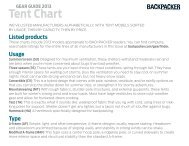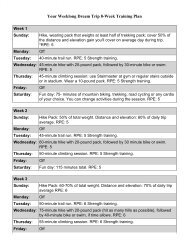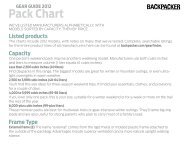BP Get Out More PDF prep
BP Get Out More PDF prep
BP Get Out More PDF prep
Create successful ePaper yourself
Turn your PDF publications into a flip-book with our unique Google optimized e-Paper software.
extend the life of your sack.<br />
10. Build a system. If you already own a perfectly good three-season<br />
bag but want a lighter, cooler bag for hot summer nights and a warmer sack<br />
Some hikers sleep so soundly that if a herd of buffalo ran through camp, they’d keep<br />
right on snoring. For the rest of us, a good night’s sleep requires a comfy mattress<br />
and a quiet campsite. Knowing how to find the right bag and use it to your best<br />
advantage also helps. Here are a few trail-tested bits of advice:<br />
At the Store: Size it up<br />
Just as ill-fitting boots will make you miserable on the trail, a sleeping bag that isn’t<br />
your size will cause you many restless nights. Even the most high-tech, expensive<br />
bag won’t work properly if it doesn’t fit.<br />
Slumber Secrets<br />
HOW TO FIND A SLEEPING BAG THAT FITS, PLUS OTHER TIPS FOR SOUND SNOOZING.<br />
When shopping for a sleeping bag, it’s essential that you try on your choices. Take<br />
off your shoes, spread the bag out on the retailer’s floor, and get in and roll around.<br />
Pay attention mainly to length and girth. There should be enough room to wiggle, but<br />
not so much that you can bring your knees up to your chest inside the bag. Excess<br />
space means more dead air for your body to expend calories heating. Here are other<br />
fitting tips:<br />
■ A snug-fitting mummy is easier to warm up than a roomy one, especially if<br />
you sleep cold or do a lot of winter camping.<br />
■ Don’t give up on mummies if you like to toss and turn, just shop around.<br />
Bag makers are coming up with innovative ways to allow you to have more<br />
freedom of movement in their mummy bags, including trapezoidal footboxes,<br />
stretch panels, and expanding draft tubes.<br />
■ Be sure to get the right size. A sack that’s too long won’t keep your feet<br />
warm because there’s too much air movement at the bottom of the bag. A<br />
bag that’s too short won’t keep your feet warm either, because your toes will<br />
press against the bottom and flatten the insulation.<br />
■ Go with the longer bag if you’re on the fence between two different lengths.<br />
A little extra room at the bottom of the bag allows you to store items that you<br />
want to keep from freezing, like full water bottles.<br />
Check construction quality<br />
When you crawl inside a bag to make sure it fits, you should tug on the drawcords<br />
and cinch the hood to evaluate its comfort. Also examine the bag for flaws and weak<br />
links using this five-point inspection:<br />
1. Check down bags for leaking feathers, a sign of poor construction or a shell that’s<br />
not densely woven.<br />
for late fall and mild winter outings, consider an overbag or liner. Both<br />
double as summer sleepers while stretching the comfort zone of your main<br />
bag for colder weather.<br />
2. Work the zipper vigorously, checking for any catches other than the usual<br />
fabric snags.<br />
3. Shake the bag from top to bottom, then from side to side. After each shaking, feel<br />
for loose or thin spots. Well-anchored synthetic fills won’t appear to shift, and adequately<br />
stuffed down baffles should feel fluffy all over.<br />
4. Test the recovery of loft by doing a press test: Push down on the bag with your<br />
hand, then let go. The bag should spring back to full height within a few seconds.<br />
If it doesn’t, the bag is doomed to lose its lofting and insulating capabilities.<br />
5. Grab the lining and shell materials of the sleeping bag and pull gently. Listen for<br />
tearing, and feel for too much give, which indicates that the baffles are loosely<br />
constructed and prone to rupturing.<br />
In Camp: Warm it up<br />
It’s 3 A.M. Your bag feels like an icebox, your teeth are chattering loudly enough to<br />
wake a hibernating bear, and your muscles are quivering in a last-ditch effort to generate<br />
heat. What can you do differently to get warm and stay warm through the night<br />
■ Cinch tight your bag’s draft collar and hood to minimize heat loss.<br />
■ A wet bag never feels warm, so avoid moisture at all costs. Put your sleeping<br />
bag in a waterproof stuff sack or garbage bag for carrying it in your<br />
backpack, and take off any wet clothes before you climb into the tent.<br />
■ Keep extra clothes and a hat handy so you can slip them on for some<br />
added warmth when you get cold.<br />
■ Fill a leak-proof bottle with hot water before you turn in, then place it in the<br />
foot of your bag or at your body’s core.<br />
■ Eat hearty, high-calorie meals to give your body calories to burn for heat,<br />
and keep a snack handy in case you need to refill your fuel tank in the middle<br />
of the night.<br />
■ Empty your bladder. Keeping that fluid warm inside your body wastes<br />
energy.<br />
■ Do 20 jumping jacks, or 5 minutes of your own favorite calisthenics just<br />
before bed and anytime during the night when your engine needs a jump<br />
start. Go to bed warm.<br />
16 GET OUT MORE!<br />
WWW.BACKPACKER.COM 17






